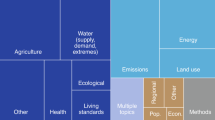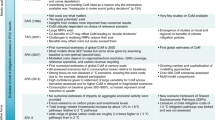Abstract
Strategies for dealing with climate change must incorporate and quantify all the relevant uncertainties, and be designed to manage the resulting risks1. Here we employ the best available knowledge so far, summarized by the three working groups of the Fifth Assessment Report of the Intergovernmental Panel on Climate Change (IPCC AR5; refs 2, 3, 4), to quantify the uncertainty of mitigation costs, climate change dynamics, and economic damage for alternative carbon budgets. We rank climate policies according to different decision-making criteria concerning uncertainty, risk aversion and intertemporal preferences. Our findings show that preferences over uncertainties are as important as the choice of the widely discussed time discount factor. Climate policies consistent with limiting warming to 2 °C above preindustrial levels are compatible with a subset of decision-making criteria and some model parametrizations, but not with the commonly adopted expected utility framework.
This is a preview of subscription content, access via your institution
Access options
Subscribe to this journal
Receive 12 print issues and online access
$209.00 per year
only $17.42 per issue
Buy this article
- Purchase on Springer Link
- Instant access to full article PDF
Prices may be subject to local taxes which are calculated during checkout



Similar content being viewed by others
References
Kunreuther, H. et al. Risk management and climate change. Nature Clim. Change 3, 447–450 (2013).
IPCC Climate Change 2013: The Physical Science Basis (eds Stocker, T. F. et al.) (Cambridge Univ. Press, 2013).
IPCC Climate Change 2014: Impacts, Adaptation, and Vulnerability. Part A: Global and Sectoral Aspects (eds Field, C. B. et al.) (Cambridge Univ. Press, 2014).
IPCC Climate Change 2014: Mitigation of Climate Change (eds Edenhofer, O. et al.) (Cambridge Univ. Press, 2014).
Cerreia-Vioglio, S., Maccheroni, F., Marinacci, M. & Montrucchio, L. Classical subjective expected utility. Proc. Natl Acad. Sci. USA 110, 6754–6759 (2013).
Savage, L. J. The Foundations of Statistics (Dover Publications, 1954).
Heal, G. & Millner, A. Uncertainty and decision making in climate change economics. Rev. Environ. Econ. Policy 8, 120–137 (2014).
Ellsberg, D. Risk, ambiguity, and the Savage axioms. Q. J. Econ. 75, 643–669 (1961).
Lempert, R. J. Shaping the Next One Hundred Years: New Methods for Quantitative, Long-Term Policy Analysis (Rand, 2003).
George, E. I. & Clyde, M. Model uncertainty. Stat. Sci. 19, 81–94 (2004).
Tebaldi, C. & Knutti, R. The use of the multi-model ensemble in probabilistic climate projections. Phil. Trans. R. Soc. A 365, 2053–2075 (2007).
Knutti, R., Furrer, R., Tebaldi, C., Cermak, J. & Meehl, G. A. Challenges in combining projections from multiple climate models. J. Clim. 23, 2739–2758 (2009).
Nordhaus, B. Warming the World: Economic Model of Global Warming (MIT Press, 2000).
Millner, A., Dietz, S. & Heal, G. Scientific ambiguity and climate policy. Environ. Resour. Econ. 55, 21–46 (2013).
Ackerman, F., Stanton, E. A. & Bueno, R. Epstein–Zin utility in dice: Is risk aversion irrelevant to climate policy? Environ. Resour. Econ. 56, 73–84 (2013).
Tavoni, M. et al. Post-2020 climate agreements in the major economies assessed in the light of global models. Nature Clim. Change 5, 119–126 (2014).
Kriegler, E. et al. The role of technology for achieving climate policy objectives: Overview of the EMF 27 study on global technology and climate policy strategies. Climatic Change 123, 353–367 (2014).
Babonneau, F., Haurie, A., Loulou, R. & Vielle, M. Combining stochastic optimization and Monte Carlo simulation to deal with uncertainties in climate policy assessment. Environ. Model. Assess. 17, 51–76 (2012).
Rogelj, J., McCollum, D. L., Reisinger, A., Meinshausen, M. & Riahi, K. Probabilistic cost estimates for climate change mitigation. Nature 493, 79–83 (2013).
Lemoine, D. & McJeon, H. C. Trapped between two tails: Trading off scientific uncertainties via climate targets. Environ. Res. Lett. 8, 034019 (2013).
Meinshausen, M. et al. Greenhouse-gas emission targets for limiting global warming to 2 °C. Nature 458, 1158–1162 (2009).
Steinacher, M., Joos, F. & Stocker, T. F. Allowable carbon emissions lowered by multiple climate targets. Nature 499, 197–201 (2013).
Urban, N. M. & Keller, K. Probabilistic hindcasts and projections of the coupled climate, carbon cycle and Atlantic Meridional Overturning Circulation system: A Bayesian fusion of century-scale observations with a simple model. Tellus A 62, 737–750 (2010).
Taylor, K. E., Stouffer, R. J. & Meehl, G. A. An overview of CMIP5 and the experiment design. Bull. Am. Meteorol. Soc. 93, 485–498 (2012).
Ackerman, F., DeCanio, S. J., Howarth, R. B. & Sheeran, K. Limitations of integrated assessment models of climate change. Climatic Change 95, 297–315 (2009).
Pindyck, R. S. Climate change policy: What do the models tell us? J. Econ. Literature 51, 860–872 (2013).
Interagency Working Group on Social Cost of Carbon. Technical Update of The Social Cost of Carbon for Regulatory Impact Analysis—Under Executive Order 12866 (United States Government, 2013).
Wald, A. Statistical decision functions. Ann. Math. Stat. 20, 165–205 (1949).
Houser, T. et al. American Climate Prospectus: Economic Risks in The United States (Rhodium Group, 2014).
Knutti, R. & Sedláček, J. Robustness and uncertainties in the new CMIP5 climate model projections. Nature Clim. Change 3, 369–373 (2013).
Calvin, K. et al. The role of Asia in mitigating climate change: Results from the Asia modeling exercise. Energy Econ. 34, S251–S260 (2012).
Riahi, K. et al. Locked into Copenhagen pledges—implications of short-term emission targets for the cost and feasibility of long-term climate goals. Technol. Forecast. Soc. Change 90, 8–23 (2013).
Kriegler, E. et al. Roadmaps Towards Sustainable Energy Futures and Climate Protection: A Synthesis of Results from The RoSE Project 1st edn (Potsdam Institute for Climate Impact Research, 2013); http://www.rose-project.org/Content/Public/RoSE_REPORT_310513_ES.pdf
Fischer, C. & Morgenstern, R. D. Carbon abatement costs: Why the wide range of estimates? Energy J. 27, 73–86 (2006).
Kriegler, E. Imprecise Probability Analysis for Integrated Assessment of Climate Change PhD thesis, Potsdam Univ. (2005)
Ricciuto, D. M., Davis, K. J. & Keller, K. A Bayesian calibration of a simple carbon cycle model: The role of observations in estimating and reducing uncertainty. Glob. Biogeochem. Cycles 22, GB2030 (2008).
Welch, B. L. The generalization of ‘student’s’ problem when several different population variances are involved. Biometrika 34, 28–35 (1947).
Tol, R. S. Targets for global climate policy: An overview. J. Econ. Dynam. Control 37, 911–928 (2013).
Weitzman, M. Handbook of Environmental Accounting 187–207 (Edward Elgar, 2010).
Weitzman, M. L. Targets as insurance against catastrophic climate damages. J. Public Econ. Theory 14, 221–244 (2012).
Moss, R. H. et al. The next generation of scenarios for climate change research and assessment. Nature 463, 747–756 (2010).
Epstein, L. G. & Zin, S. E. Substitution, risk aversion, and the temporal behavior of consumption and asset returns: A theoretical framework. Econometrica 57, 937–969 (1989).
Gilboa, I. & Schmeidler, D. Maxmin expected utility with non-unique prior. J. Econ. Perspect. 18, 141–153 (1989).
Stern, N. The Economics of Climate Change: The Stern Review (Cambridge Univ. Press, 2007).
Nordhaus, W. D. & Weitzman, M. L. A Review of the “Stern Review on the Economics of Climate Change”. J. Econ. Literature 45, 703–724 (2007).
Vissing-Jörgensen, A. & Attanasio, O. P. Stock-market participation, intertemporal substitution, and risk-aversion. Am. Econ. Rev. 93, 383–391 (2003).
Bansal, R. & Yaron, A. Risks for the long run: A potential resolution of asset pricing puzzles. J. Finance 59, 1481–1509 (2004).
Acknowledgements
We thank K. Keller from the Pennsylvania State University for supplying the climate model and his support. The paper was written while V.B. and M.T. were fellows at the Center for Advanced Studies in the Behavioural Sciences (CASBS) at Stanford University. The research leading to these results has received funding from the Italian Ministry of Education, University and Research and the Italian Ministry of Environment, Land and Sea under the GEMINA project, from the EU FP7 under grant agreement no. 308329 (ADVANCE) and from the European Research Council 336703-RISICO at IEFE, Bocconi University.
Author information
Authors and Affiliations
Contributions
All authors were involved in designing the research and contributed equally to the writing of the manuscript. L.D. performed the scientific computing.
Corresponding author
Ethics declarations
Competing interests
The authors declare no competing financial interests.
Supplementary information
Rights and permissions
About this article
Cite this article
Drouet, L., Bosetti, V. & Tavoni, M. Selection of climate policies under the uncertainties in the Fifth Assessment Report of the IPCC. Nature Clim Change 5, 937–940 (2015). https://doi.org/10.1038/nclimate2721
Received:
Accepted:
Published:
Issue Date:
DOI: https://doi.org/10.1038/nclimate2721
This article is cited by
-
Carbon price prediction under output uncertainty
Environmental Science and Pollution Research (2022)
-
Robust decision outcomes with induced correlations in climatic and economic parameters
Mitigation and Adaptation Strategies for Global Change (2022)
-
On the optimality of 2°C targets and a decomposition of uncertainty
Nature Communications (2021)
-
Evaluating process-based integrated assessment models of climate change mitigation
Climatic Change (2021)
-
A Satisficing Framework for Environmental Policy Under Model Uncertainty
Environmental Modeling & Assessment (2021)



